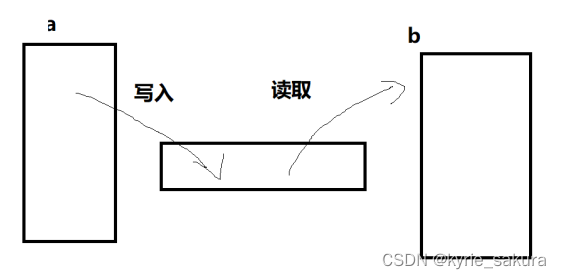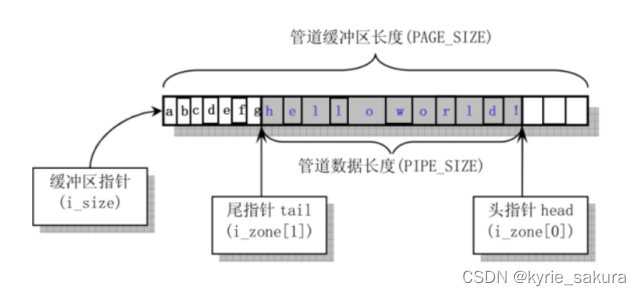一、进程间通信
前言
进程间通信
进程间通信的方法
(1)管道
(2)信号量
(3)共享内存
(4)消息队列
(5)套接字
你了解的IPC机制都有哪些?
二、管道
1、管道简介
| 命令:
举例:ps -ef | grep “sleep”
两个进程通信,比如a,b进程,a向管道中写入数据,b读取数据;

管道的分类:有名管道和无名管道
区别:
有名管道在任意两个进程间通信,
无名管道在父子进程间通信;
2、有名管道的创建
创建的命令:mkfifo
打开管道:open();
读数据:read();
写入数据:write();
关闭管道:close();
3、相关思考
如果进程 a 要将从键盘获取的数据传递给另一个进程 b, 用已具备的知识思考应该如何完成 ?
创建管道之后,它会在内存上分配一块空间,表面上看把数据写入管道中了,实际上是把数据写入内存中了。另外一个程序是从内存中读取数据的,所以效率是比较高的。
管道文件:大小永远为0;
4、有名管道实现进程间通信
又名命名管道;
代码实现:
a.c
//a.c
#include <stdio.h>
#include <stdlib.h>
#include <unistd.h>
#include <string.h>
#include <assert.h>
#include <fcntl.h>
int main()
{
int fd=open("fifi",O_WRONLY);
assert(fd!=-1);
printf("fd=%d\n",fd);
write(fd,"hello",5);
close(fd);
}
b.c
//b.c
#include <stdio.h>
#include <stdlib.h>
#include <unistd.h>
#include <string.h>
#include <assert.h>
#include <fcntl.h>
int main()
{
int fd=open("./fifi",O_RDONLY);
assert(fd!=-1);
printf("fd=%d\n",fd);
char buff[128]={0};
read(fd,buff,127);
printf("read:%s\n",buff);
close(fd);
}
5、管道的特点:
(1)管道必须读,写进程同时open,否则会阻塞;
(2)如果管道中没有数据,那么read就会阻塞;
(3)管道的写端关闭,读read返回值为0;
(4)管道打开的时候只有只读和只写方式,读写方式是未定义的;
6、将上面的代码改为循环
a.c
//a.c
#include <string.h>
#include <assert.h>
#include <fcntl.h>
int main()
{
int fd=open("fifi",O_WRONLY);
assert(fd!=-1);
while(1)
{
printf("input:\n");
char buff[128]={0};
fgets(buff,128,stdin);
if(strncmp(buff,"end",3)==0)
{
break;
}
write(fd,buff,strlen(buff));
}
close(fd);
}
b.c
//b.c
#include <stdio.h>
#include <stdlib.h>
#include <unistd.h>
#include <string.h>
#include <assert.h>
#include <fcntl.h>
int main()
{
int fd=open("./fifi",O_RDONLY);
assert(fd!=-1);
printf("fd=%d\n",fd);
while(1)
{
char buff[128]={0};
if( read(fd,buff,127)==0)
{
break;
}
printf("read:%s\n",buff);
}
close(fd);
}
7、无名管道的介绍
使用pipe创建无名管道,只能进行父子间的通信;
pipe是一个系统调用
int pipe(int fds[2]);
//pipe()成功返回 0,失败返回-1
//fds[0]是管道读端的描述符
// fds[1]是管道写端的描述符
//规定
代码演示:
父进程写入数据,子进程读取数据;
#include <stdio.h>
#include <stdlib.h>
#include <unistd.h>
#include <string.h>
#include <assert.h>
int main()
{
int fd[2];
assert(pipe(fd)!=-1);
pid_t pid=fork();//先open,再frok,父子进程共享打开的文件描述符
assert(pid!=-1);
if(pid==0)
{
close(fd[1]);
char buff[128]={0};
read(fd[0],buff,127);
printf("child read:%s\n",buff);
close(fd[0]);
}
else
{
close(fd[0]);
write(fd[1],"hello",5);
close(fd[1]);
}
exit(0);
}
8、管道的特点:
(1)管道必须读,写进程同时open,否则会阻塞;
(2)如果管道中没有数据,那么read就会阻塞;
(3)管道的写端关闭,读read返回值为0;
(4)管道打开的时候只有只读和只写方式,读写方式是未定义的;
(5)管道是半双工的(某一时刻只能选择一个方向)(面试重点)、(通信方式有单工,半双工,全双工)
(6)无论有名还是无名,写入管道的数据都在内存中(面试重点)
(7)有名管道和无名管道的区别:(面试重点)
有名可以在任意进程间通信
无名主要在父子进程间通信
(8)管道的读端关闭,写会产生异常(发送信号SIGPIPE)(可以改变信号的响应方式验证一下)
9、管道的实现
























 1750
1750











 被折叠的 条评论
为什么被折叠?
被折叠的 条评论
为什么被折叠?








